Understand your Horse – Part 20
|
|
Ihr Pferd verstehen – Teil 20
|
The Tail
- In the last part we concluded the language of the horse’s neck – this leaves us to look at the expressions of the tail and his legs.
- The function of the tail is of course mainly to get rid of annoying flies in the spots, where the head cannot reach them. With the tail the horse can reach his hind legs and around his belly as well as under it. But the tail is also a great means of communication!
- Desmond Morris (in “Horse Watching”) says that the horse’s tail “rises and falls like a needle on a dial that registers excitement”, part of which we already mentioned, when talking about the horse’s whole body and general muscle tension.
- “ …the tail is the anti-gravity balance of the muscle system, and has then, even without motion, turned into a signal for the others.”
1) Drooped tail:
- A limply drooped tail indicates low muscle tension and is shown by horses that are sleepy, exhausted or weak. It indicates that there is no reason for excitement or aggression, and no reason for flight mood.
|
|
Der Schweif
- Im letzten Teil beendeten wir die Interpretation der Gesten des Pferdes mit dem Hals – nun bleibt uns noch die Sprache des Schweifs und der Beine.
- Die Funktion des Schweifs ist natürlich hauptsächlich die Abwehr plagender Fliegen an den Stellen, die mit dem Maul nicht erreicht werden können. Der Schweif deckt die Gegend um die Hinterbeine und unter dem Bauch ab. Aber er ist auch ein wunderbares Mittel der Verständigung!
- Desmond Morris sagt (in “Horse Watching”), daß der Schweif des Pferdes „wie ein Zeiger auf einer Skala der Erregung ansteigt und abfällt“, was wir ja teilweise schon bei der Besprechung der allgemeinen Muskelanspannung im ganzen Körper erwähnt haben.
- „… der Schweif ist die Anti-Schwerkraft Balance des Muskelsystems, and hat sich dann, auch ohne Bewegung, zum Signal an andere gewandelt.“
1) Hängender Schweif:
- Ein schlaff hängender Schweif ist ein Zeichen von niedriger Muskelspannung von Pferden, die schlafen, erschöpft oder geschwächt sind. Da gibt es weder Anzeichen für Aufregung oder Aggression, noch Grund zur Flucht.
|
 Limply drooping tails indicate sleep, submission or exhaustion.
Schlaff hängende Schweife sind Zeichen von Schläfrigkeit, Unterwürfigkeit oder Erschöpfung.
|
- When a horse wants to convey submission to another in order to avoid a conflict, he will therefore also signal is thus by letting the tail hang (and show submissive ears, eyes, turning the neck etc., as mentioned before).
- When the tail droops limply while riding, your horse needs perhaps a bit more motivating, as it is not a sign of intense interest in what you are doing!
But note:
- Like we so often observed while looking at his other body parts (ears and eyes in particular) we must be alert to the fact that all indications of seeming sleepiness can also be an expression of pain!
|
|
- Wenn ein Pferd einem anderen Unterwürfigkeit andeuten will, damit ein Konflikt vermieden werden kann, wird es auch so den Schweif hängen lassen (mit unterwürfigen Ohren, Augen, einem Wegdrehen des Kopfes etc., wie schon besprochen).
- Wenn Ihr Pferd beim Reiten so den Schweif hängen läßt, muß es vielleicht ein wenig besser motiviert werden, denn das ist kein Zeichen von intensivem Interesse an dem was Sie tun!
Aber Achtung:
- Wie schon öfter beobachtet (als wir die anderen Körperteile besprachen, z.B. Ohren und Augen) müssen wir immer im Auge behalten, daß scheinbare Anzeichen von Schläfrigkeit auch ein Ausdruck von Schmerz sein können!
|
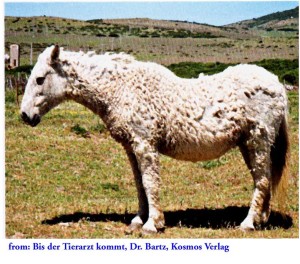 Sick horses also let their tails droop, so it can be a sign of pain! Always check for the cause.
Auch kranke Pferde lassen den Schweif hängen, es kann ein Zeichen von Schmerzen sein! Immer die Ursache prüfen. |
- Sick horses let their tails droop, as do horses suffering from exhaustion or heat stroke. Always check the surrounding condition before jumping to conclusions!
2) Carried tail:
- Looking at an alert, healthy, awake and interested horse, you would always see a carried tail – regardless of the activity.
|
|
- Kranke Pferde lassen den Schweif hängen, auch solche, die an Erschöpfung oder Hitzschlag leiden. Also immer die Begleitumstände prüfen, ehe man voreilige Schlüsse zieht!
2) Getragener Schweif:
- Wenn Sie ein munteres, waches und interessiertes Pferd betrachten, werden Sie immer einen getragenen Schweif sehen – egal welche Tätigkeit es momentan verfolgt.
|
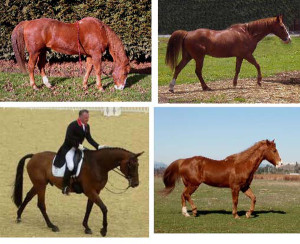 A healthy, awake, alert horse will never let his tail droop limply!
Ein gesundes, waches, interessiertes Pferd wird nie den Schweif schlaff hängen lassen!
|
- Whether grazing, or just walking from A to B (top), whether cooling out in extension posture or trotting after the herd (bottom), the tail would not droop!
- Carrying the tail is a sign of, and readiness for activity. When the horse carries his tail it shows engagement in what is going on. This is what we like to see when riding or playing with our horses. It indicates a generally heightened muscle tone and gives the horse that “proud” look which is part of his grace of movement. His energy is “up” and often the raising of the tail goes along with an increase of tempo.
|
|
- Ob es grast, oder nur von A nach B läuft, ob Sie es in der Erholungsphase in Dehnhaltung reiten, oder es der Herde nachtrabt (unten), würde der Schweif nie einfach hängen!
- Ein getragener Schweif ist ein Zeichen der Bereitschaft für Aktivität. Das Pferd zeigt Engagement an seiner Umwelt. Das ist es, was wir sehen wollen, wenn wir reiten oder mit unseren Pferden spielen. Es zeigt einen generell erhöhten Muskeltonus und gibt dem Pferd das „stolze“ Aussehen, welches ein Teil seiner Bewegungsgrazie ist. Es deutet auf Energie hin, so daß das Anheben des Schweifs oft auch mit einem verstärkten Tempo einher geht.
|
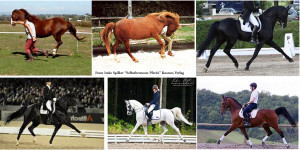 In play as well as under the rider the horse will carry his tail proudly as part of his grace of movement.
Im Spiel und unter dem Reiter wird ein Pferd in anmutiger Bewegung stolz seinen Schweif tragen. |
- As a horse is designed for speed, the tail is part of the balance system. The faster the horse moves, the more “streamlined” his entire appearance, including the bearing of the tail. Pictures of extended trot in dressage come to mind.
3) High Tail: also flicking
- A tail carried high, by which we mean above the horizontal and sometimes sticking up almost vertically, indicates exuberance or high excitement. I call it: the horse is flying his flag.
- In the picture on the right you see that the tail is carried like this, although the horse is exploring something at slow speed – but obviously something very exciting! The young horse in the centre is bursting with exuberance: his tail says: “let’s go and dash off to play”, while the horse on the left seems startled and rather in flight mode.
|
|
- Da das Pferd sich auf Geschwindigkeit hin entwickelt hat, ist sein Schweif ein Teil seines Balancesystems. Je schneller es sich bewegt, desto mehr ist seine ganze Erscheinung stromlinienförmig, eben auch die Haltung des Schweifs. Man denke an Bilder des verstärkten Trabs in der Dressur.
3) Hochgereckter, auch schnippender Schweif:
- Damit meine ich einen Schweif, der über die Horizontale, manchmal sogar vertikal, gestreckt wird. Der zeigt hohe Erregung oder Überschwang an. Ich nenne das: das Pferd zieht seine Fahne auf.
- Im Bild rechts sieht man, daß, obwohl das Pferd etwas mit niedrigem Tempo erforscht, es dennoch den Schweif so hoch reckt – denn offensichtlich ist es etwas sehr Aufregendes! Das junge Pferd (Mitte) platzt fast vor Ausgelassenheit: sein Schweif sagt: „laß uns losrennen und spielen!“, während das Pferd links eher erschreckt und in Fluchtstimmung zu sein scheint.
|
 High Tails are a sign of excitement and exuberance – also an invitation to play!
Solch hohe Schweife sind ein Zeichen von Erregung und Überschwang – auch eine Aufforderung zum Spielen! |
- Particularly male horses hold their tail like this during display behavior, prancing and showing off. When Beau does it while playing off-line he is decidedly cheeky – and I already KNOW that he will not listen, but rather pull off his own program – but always with a lot of joy (so I usually let him…). When I then call him and he chooses to listen, he will arrive at full tilt! In situation like this, be ready for exuberance in all its manifestations!
|
|
- Vor allem männliche Pferde halten ihren Schweif so beim Imponiergehabe, wenn sie tänzelnd angeben. Wenn Beau beim frei spielen so den Schweif hochreckt, dann ist er eindeutig in frecher Stimmung und ich weiß schon vorher, daß er nicht gehorchen, sondern eher sein eigenes Programm vorführen wird – aber immer mit so viel Stolz (so daß ich ihn meist lasse…). Wenn ich ihn dann herbeirufe, kommt er aber volle Pulle! In solchen Situationen muß man auf Überschwang mit allem Drum und Dran gefaßt sein!
|
 High tails are part of display behaviour – showing off requires high muscle tension!
Hohe Schweife sind Teil des Imponiergehabes – Angeben erfordert hohem Muskeltonus!
|
- In all the pictures above, whether displaying himself to other horses or under the rider to an audience, or whether just showing plain exuberance and pride in his own prancing, the horse’s tail is carried relatively high.
- Desmond Morris (in “Horse Watching”) tells us that the expression “high-tailing it out of there” comes from cheating horse-traders, who want to make their goods look more chipper than they actually are, by inserting a piece of ginger into the horse’s anus – which results in a similar high tail (and obviously also speed!), but caused from pain rather than exuberance…
- (We left out the description of the sexual connotation of a tail carried high and sideways, which is displayed by a mare in heat and signals an invitation to the stallion to serve her, as it is not significant as communication toward us.)
4) Pinched tail:
- A horse showing a pinched tail is acutely afraid or in distress, like a dog with his tail between his legs. My traumatized Beau pinched his tail for years whenever I came close to his hind end with a brush. The rod also shivered – how they must have beaten that poor thing before he got rescued! When you see a pinched tail with your own horse, a lot of trust training is in the order. A trauma of previous mistreatment may never be totally disappear, but you can certainly alleviate it.
|
|
- In all den Bildern oben, ob beim Imponiergehabe vor anderen Pferden oder unter dem Reiter vor Zuschauern, oder einfach nur im Überschwang und stolzem Herumtänzeln, – immer ist der Schweif ziemlich hoch getragen.
- Desmond Morris (in “Horse Watching”) erklärt, daß der Ausdruck “high-tailing it out of there” (amerikanisch: davon flitzen, absausen) daher kommt, daß früher betrügerische Pferdehändler im Versuch ihre Ware munterer vorzuführen als sie eigentlich war, dem Pferd ein Stück Ingwer in den Anus gesteckt haben – was darin resultierte, daß auch so ein hochgereckter Schweif (und offensichtlich auch das dazugehörende Tempo!) gezeigt wurde – nun aber aus Schmerz anstatt Überschwang…
- (Wir lassen hier den hoch getreckten und seitwärts gehaltenen Schweif aus, den eine rossige Stute als Signal ihrer Verfügung an den Hengst zeigt, da es mit der Kommunikation an uns nichts zu tun hat.)
4) Eingeklemmter Schweif:
- Wenn ein Pferd den Schweif einklemmt ist es in einer Notlage oder akut verängstigt, wie ein Hund, der den Schwanz einklemmt. Mein traumatisierter Beau hat jahrelang seinen Schweif so eingeklemmt, wenn immer ich auch nur mit einer Bürste seinem Hinterteil nahekam. Er zitterte dabei auch stark – wie sie das arme Tier geschlagen haben müssen, bevor er gerettet wurde! Wenn Sie bei Ihrem Pferd so einen eingeklemmten Schweif beobachten, dann brauchen Sie auch eine Menge Vertrauenstraining. Das Trauma einer früheren Mißhandlung mag nie ganz verschwinden, aber man kann es wenigstens vermindern.
|
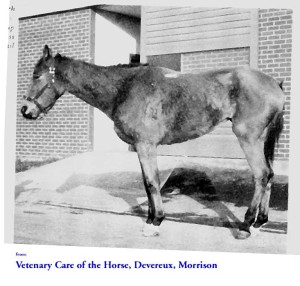 A pinched tail is a sign of distress or acute anxiety or fear.
Ein eingeklemmter Schweif ist ein Zeichen einer Notlage oder akuter Angst.
|
5) Stiff rod:
- This is a stiffening of the fleshy base of the tail so it sticks out horizontally – a very aggressive or tense signal of the horse!
- As this is something you would mainly see in a herd during the attack on another horse, I don’t have an appropriate picture. Let us hope that you will not see this gesture directed toward you!
6) Swishing tail:
- The horse swishes his tail to rid himself of annoying pests (top left) – and then has translated this gesture into a symbolic indication that he would like to free himself of a persisting irritation. This unfortunately we see all too often during interaction of horse and humans!
|
|
5) Steife Schweifrübe:
- Wenn die Schweifrübe steif und horizontal herausgestreckt wird, ist das ein sehr aggressives und verspanntes Signal des Pferdes!
- Da dies meist in der Herde beim Angriff auf ein anderes Pferd vorkommt, habe ich kein Bild davon. Hoffen wir, daß Sie niemals diese Geste gegen sich gerichtet sehen müssen!
6) Peitschender Schweif:
- Ein Pferd schlägt mit dem Schweif, um plagende Fliegen loszuwerden (oben links) – und dann hat sich diese Geste in ein symbolisches Zeichen gewandelt, das den Wunsch zeigt, eine anhaltende Irritation loszuwerden. Leider sieht man das allzuoft beim Miteinander von Pferd und Mensch!
|
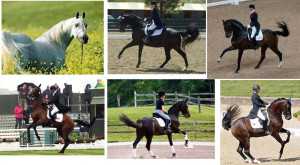 When the horse is annoyed he swishes his tail as if to rid himself of annoying pests – don’t be one!
Wenn das Pferd sich ärgert schlägt es mit dem Schweif wie um lästige Fliegen loszuwerden – seien Sie keine solche Plage!
|
- A swishing tail, particularly under the rider, can indicate a gamut of feelings, from extreme anxious concentration, to frustration, confusion all the way to anger. Horses rolled in with reins that are too short, and especially the application of spurs (very often seen during flying changes!) may be the cause of such annoyance. Dressage judges will (or at least should!) give deductions for lessons shown with a constantly swishing tail, as this is not a sign of the harmony between a happy horse and a sensitive rider, which are an essential part of good dressage!
7) Twisting Tail:
- Twisting tails are often the follow-up after swishing it right and left and then over the vertical in an arc all the way around – a sure sign that the horse is very ill at ease and quite annoyed. It is often used as an increase in intensity from merely swishing the tail, and you should pay attention, as other forms of irritation or rebellion may follow. If you want to be a good friend of your horse’s, check for the cause of such frustration and remove it!
8) Slapping the tail hard:
- The horse will increase the intensity of his tail movement again in situations where he cannot get at the source of irritation – perhaps a horsefly has landed in a spot, where the tail does not reach despite desperate attempts. The horse now gets so frustrated that it borders on fury – beware, if he shows this as a signal toward you! If he does, you better change the situation instantly – and also take care to establish a better relationship with your partner! If you don’t take steps to remedy the situation after seeing your horse slapping the tail hard, the kick will mostly follow….
- which leads us to the topic of the next Blog, the communication of the horse with his legs!
Read on!!!
|
|
- Vor allem unter dem Reiter kann ein peitschender Schweif eine ganze Skala von Gefühlen ausdrücken, von extremer, ängstlicher Konzentration, über Frust und Verunsicherung bis zu richtigem Zorn. Wenn Pferde mit zu kurzen Zügeln eingerollt oder (vor allem bei fliegenden Wechseln) mit den Sporen gestochen werden, dann kann das z. B. der Anlaß solcher Verärgerung sein. Dressurrichter werden daher (oder sollten es zumindest!) für Lektionen, die mit konstant peitschendem Schweif vorgeführt werden, Abzüge geben, da dies kein Anzeichen von glücklichem Pferd mit einfühlsamem Reiter ist, das doch ein so essentieller Teil guter Dressur sein sollte!
7) Schweif-Zwirbeln:
- Das folgt meist auf ein Peitschen rechts-links gefolgt von vertikalem Anheben – dann zwirbelt der Schweif in großem Bogen – ein sicheres Zeichen, daß das Pferd sich äußerst unwohl fühlt und sehr verärgert ist. In der Intensität ist es eine Steigerung des Schweif-Peitschens, und man sollte aufpassen, denn noch stärkere Formen der Rebellion könnten folgen. Wenn Sie ein guter Freund Ihres Pferdes sein wollen, suchen Sie nach dem Grund der Verärgerung und beseitigen Sie diese!
8) Den Schweif hart schlagen:
- Das Pferd wird die Intensität seines Signals nochmals steigern, wenn es die Ursache der Irritation nicht beseitigen kann – vielleicht sitzt eine Pferdebremse an einer Stelle wo der Schweif trotz verzweifelter Versuche nicht hinlangt. Das Pferd wird dann so frustriert, daß es an Wut grenzt – aufgepaßt, wenn es den Schweif so gegen Sie schlägt! Sollte das wirklich vorkommen, so verbessern Sie die Situation sofort, denn sonst wird vermutlich ein Austreten folgen…
- was uns dann zum Thema des nächsten Blogs führt – der Kommunikation des Pferdes mit seinen Beinen!
Lesen Sie weiter!!
|









